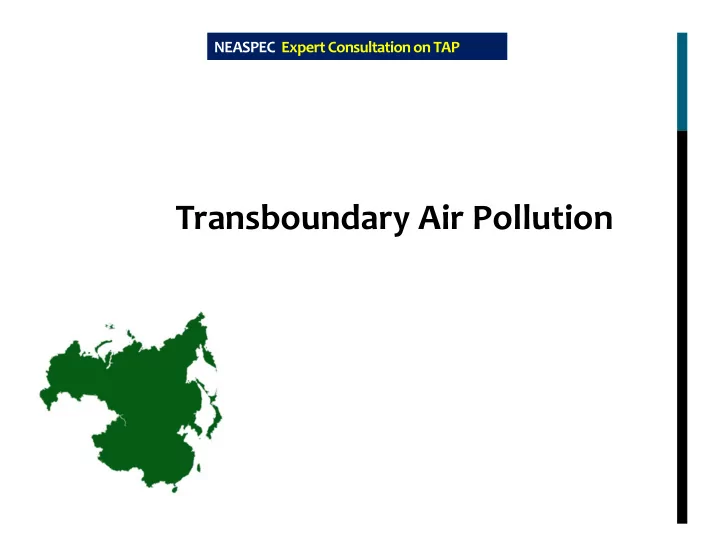

NEASPEC Expert Consultation on TAP Transboundary Air Pollution
NEASPEC: building the foundation for collaboration on transboundary air pollution through technical projects, and now moving onto the next stage 2014- •New programme on TAP assessment 2010-2013 and subregional •Identifying new framework NEASPEC 1996-2011 approaches and •Technical assistance programme on air pollution mitigation from coal-fired power Holistic program Holistic program Connection between Connection between plants (monitoring, modeling, (monitoring, modeling, science and policy science and policy impact assessment) impact assessment) 3 rd phase project components New subregional New subregional (1 ) Air Pollution Abatement Plans; ( 2 ) SO2 strategy/ framework strategy/ framework Emission Regulation and Compliance; ( 3 ) Mongolian Power Plant Emission Standards; ( 4 ) Open and effective Open and effective Knowledge Transfer and Dissemination; ( 5 ) Air pollution-climate Air pollution-climate Demonstration Project and Management exchange of knowledge exchange of knowledge interaction (SLCPs) interaction (SLCPs) Modules and data and data
Development of the technical and policy frameworks for transboundary air pollution assessment and abatement Proposal by the Russian Government as follow-up to the Review project in 2012 Presented to SOM-17 (Dec. 2012) and endorsed at SOM-18 (Nov. 2013) Goals: Assess options for establishing a science-based and policy-supported cooperation framework in North-East Asia for the assessment and mitigation of transboundary air pollution Target pollutants: PM 2.5 , PM 10 and Ozone and their linkages with other pollutants including SO x , NO x , Black Carbon, NH 3 and VOCs. Priorities of the framework: (a) modeling of source-receptor relationship of transboundary air pollution, (b) policy scenarios, (c) emission inventory, (d) abatement technology assessment, (e) impact assessment, etc.
Implementation of the project Key Work Components Modeling of source-receptor relationship of transboundary of Particulate Matter • (PM2.5 and PM10) Formulating recommendations on science-policy linkage and health impact • assessment Development of the concept of the cooperation framework • Implementing body Lead agency: Scientific Research Institute • for Atmospheric Air Protection (SRI), the Russian Federation Collaborating agencies: Respective • national institutions including the Chinese Research Academy of Environmental Sciences and Busan National University, Republic of Korea, and national experts involved in LTP modeling. Proposed domain for the Project (30 ° N-60 ° N and 100 ° E-145 ° E)
Implementation of the Project: 2014-2016 Develop a detailed scope and approach of the project (Expert consultation meeting, May 2014) Assess data and technical approaches, and prepare a joint modelling methodology (Consultation workshop, March 2015/ consultation with LTP experts, Nov. 2015) Carry out modelling of transboundary air pollution and conduct a background study (by Dec 2016) Formulate the concept of a subregional framework on assessment and mitigation of transboundary air pollution (by Dec 2016) Intergovernmental consultations and decisions on the framework (Sep 2014, Feb 2016 and 2017)
Science-Policy Linkage An example of science-policy linkage: CLRTAP Science providing relevant data • carrying out atmospheric and effects modeling • analyzing dose response and critical loads • developing emission inventories • carrying out integrated assessment; and • developing science-policy recommendations • Policy addressing linkages with climate change, biodiversity and other cross- • sectoral considerations exchanging information and good practices • developing and disseminating guidance documents •
Policy Scenario Integrated assessment modeling for policy scenario: (a) abatement options for reducing multiple air pollutants and GHGs, and structural measures in major sectors (b) projections of emissions (c) assessments of the atmospheric transport of substances (d) analysis and quantification of the environmental and health effects and benefits of emission reductions Policy scenario for air pollutions in Northeast Asia 40 35 30 Countries include China, DPRK, Mongolia, 25 Japan and ROK NOx 20 PM2.5 Scenarios are based on the combination NMVOC of end-of-pipe control measures and 15 energy-saving policies 10 5 Source: Wang S. X. et.al. 2014. Emission trends and mitigation 0 2010 2020 BAU[0] 2020 BAU[1] 2020 PC[0] 2020 PC[1] options for air pollutants in East Asia, Atmos. Chem. Phys., 14,
あ あ あ ありがとうございま りがとうございま りがとうございます りがとうございま す 감사합니다 す す THANK YOU 谢谢 谢谢 谢谢 та б ү хэнд баярлалаа 谢谢 감사합니다 감사합니다 спасибо 감사합니다
Recommend
More recommend